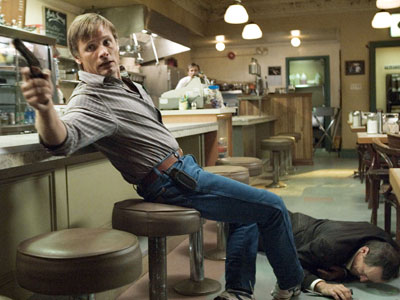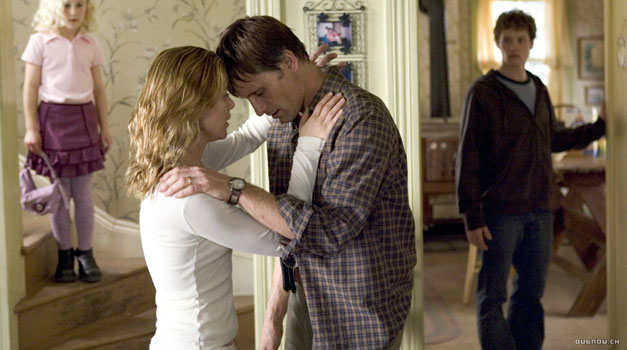From the Chicago Reader (September 30, 2005). The last illustration, incidentally, is from the graphic novel that this film is based on.,,,See below for screenwriter Josh Olson’s recent response to this review. — J.R.
A History of Violence
**** (Masterpiece)
Directed by David Cronenberg
Written by Josh Olson
With Viggo Mortensen, Maria Bello, Ed Harris, Ashton Holmes, William Hurt, and Heidi Hayes
Tom Stall (Viggo Mortensen) is a happy family man running a diner in idyllic small-town Indiana, with a lawyer wife (Maria Bello), a teenage son (Ashton Holmes), and a little girl (Heidi Hayes). One night he responds so deftly and definitively to the violent threats of two killers that he becomes a local hero. A Philadelphia mobster named Carl Fogarty (Ed Harris) hears of the story and soon arrives in town claiming that Tom has another name and background — that he was once a gangster himself who mutilated one of Fogarty’s eyes with barbed wire.
Is A History of Violence a popular genre movie, soliciting visceral, unthinking responses to its violence while evoking westerns and noirs? Or is it an art film, reflecting on the meaning, implications, and effects of its violence, and getting us to do the same? David Cronenberg’s genius here is the way he makes it impossible to settle this question.
You can’t logically claim that it’s both kinds of movie at once — the devices and intentions of one interfere with those of the other. Yet Cronenberg is so adept at tinkering with our thoughts about violence that he comes very close to pulling off this feat. He provokes confused emotional responses — laughter at serious moments and spontaneous applause at some of the violent ones — that might embarrass us, but Cronenberg isn’t engaging in parody or irony. Nor is he nihilistically pandering to our worst impulses: the filmmaking is too measured and too intelligent. He implicitly respects us and our responses, even when those responses are silly or disturbing.
There’s hardly a shot, setting, character, line of dialogue, or piece of action in A History of Violence that can’t be seen as some sort of cliché. Its fantasies about how American small towns are paradise and big cities are hell are genre standbys that Cronenberg milks at every turn. But none of this plays like cliché; Cronenberg is such an uncommon master of tone that we’re in a state of denial about our familiarity with the material — a kind of willed innocence that resembles Tom Stall’s own disavowals. (Warning: what follows is full of spoilers.)
Cronenberg keeps his camera too close to Stall’s violence to let us feel detached from it. He also takes care to show the immediate consequences of violence — such as what a shotgun can do to someone’s face — without rubbing our noses in it. But our proximity never allows for any simple identification with Stall — or if it does, we eventually feel penalized because we don’t really know who he is. (His elected surname surely isn’t irrelevant.) There’s a similar ambiguity in that Cronenberg has spent most of his life and career in Toronto; you might call him a next-door neighbor to the American dream, which includes the cherished idea that we can start our lives over again with a clean slate. We seem to believe and doubt that idea with equal conviction, and the uneasy laughs the film draws out reflect this familiar brand of doublethink.
So do the two remarkable sex scenes between Tom and his wife before and after she learns about his violent past (reportedly Cronenberg’s main contributions to Josh Olson’s script). In the first, she starts out dominant, playfully dressed as a cheerleader (“because we never got to be teenagers together”), though he winds up on top; the second is spurred by his rough aggression, and she’s turned on even though she no longer wants to share the same bed with him. Both scenes testify to the uncommon skills of Mortensen and Bello: they expose more layers of personality than we can possibly keep up with.
At Cannes last May Alexander Horwath — director of the Austrian Film Museum and one of Europe’s best film critics — caused a minor scandal by loudly berating his colleagues for laughing during a screening of the film. It’s easy to feel superior to this behavior, especially since Cronenberg himself has said he doesn’t regard laughter as an inappropriate response to certain scenes. But I think Horwath’s anger is in some ways a sensitive response. Cronenberg isn’t a posthumanist cynic like Lars von Trier, whose nihilism we honor by jeering along with him. Cronenberg is a troubled moralist who doesn’t succumb to political correctness about violence, and the meaning of our laughter, however “appropriate,” is part of what bothers him.
I’ve seen the film twice, with very different audiences — at a gala in Toronto with the filmmakers and cast present and at a local preview with a mainly younger crowd — and it was uncanny to hear both the laughter and spontaneous applause occur at precisely the same places. The most memorable instances followed two scenes in which Tom’s teenage son, Jack, is taunted, insulted, and provoked at school by a classmate.
The first time, in a locker room, Jack defuses the tension, lightly mocking the insults by accepting and even embroidering them. The second time, in a hallway, he again tries to remain cool, but when that doesn’t work he beats both the bully and his friend to a bloody pulp. The audience all but cheered — boorishness won out. Even after we learn that both boys have landed in the hospital, their families might sue, Jack has been suspended from school, and Tom is furious, Jack’s stupidity and momentary loss of control are still being celebrated. (A moment later, a similar point gets made when Tom says to Jack, “In this family, we don’t solve problems by hitting people.” Jack snaps back, “No, we shoot them,” and Tom slaps him in response, immediately disproving his point. This time no one applauded, at either screening.)
Jack’s comebacks in the locker room got some laughs, but certainly not applause. I’d wager this has to do with our programmed responses to genre; thoughtful responses (which you might call “art-house” responses) are likely to come later and more slowly. But in either case Cronenberg sets up our reactions, both simple and complex, with equal care. Combined with the visceral responses he creates, our thoughts become more than theoretical — we wind up experiencing them in our gut.
***
Postscript (6/25/2015): Josh Olson, the screenwriter of A History of Violence, has just posted the following helpful response to this review on Facebook:
Very nice piece, and thanks, Scott, for hipping me to it.
Jonathan, if I could quibble with one thing… I get the need critics have to credit the director with everything the writer does… but sometimes one must speak up. To wit:
“So do the two remarkable sex scenes between Tom and his wife before and after she learns about his violent past (reportedly Cronenberg’s main contributions to Josh Olson’s script).”
Nope. Those scenes were not in my first draft. That much is absolutely true. When David came on board the project, as a huge fan of his work, I struggled to come up with a way to sign the film with his name. Obviously, biological mutations were out, so what I was left with was a complex, potentially disturbing, adult sex scene.
I told David I was going to come up with a scene that wouldn’t feel out of place in one of his movies, and he nixed the idea, told me flat out that he didn’t want the film to be too “Cronenbergy” (His word). I told him I’d come up with a scene so good he’d HAVE to put it in the film.
I count the fact that I managed to do that – and that that scene routinely gets pointed to as a quintessentially “Cronenbergy” scene – as one of the few unequivocal achievements of my life.
The rest – that interesting dichotomy you write so eloquently about – comes mostly from my deep love of genre films combined with my deep desire to make movies that speak to something real. It was basically an attempt to have our cake and eat it, too.
I’m a gigantic fan of Unforgiven, which I saw twice in theaters when it came out. I remember there were always people in the audience who cheered when the guy gets killed in the outhouse. The first time, it annoyed me. The second time, I got it. This movie works for the people who seek nothing more than cheap, visceral action movie thrills. But it also subverts those thrills, and can be appreciated on both levels. And, in fact, it works best if you can groove on both levels at the same time.




